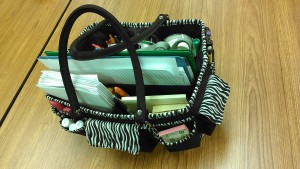How do we get students to love writing? The key to writing instruction (like anything), is the sales pitch. You have to “sell” your kids on writing. Make them believe that writing is the best time they will ever have in school. Gimmicks work; check out my bag of tricks for writing.
When I enter the room carrying this, the kids take notice. I circulate around the room during writing time. Students are buckling down, writing away. I stop near a student, talk a few minutes about his writing, and hit one teaching point. I may give him a sticky note to add some details, pull out some scissors so I can cut the writing apart, leaving a space to add more details in the middle, or give a fun colored gel pen to do some revising. As I dig into the bag for something, and it’s like E.F. Hutton is talking–everyone leans in, nearly falling out of chairs, to listen.
What’s in the bag?
In the bag, I keep anything I think students may need. This could be in a writing station, but I find it handy because I travel to different classrooms.
- different kinds of paper–loose leaf paper, little drafting booklets, scrapbooking paper, handwriting paper, etc.
- topics chart–a blank chart for students to list people they know, places they have been, things they know a lot about, and things they like to do
- variety of sticky notes–all shapes and sizes to use for jotting information, organizing ideas, or adding revisions
- proofreading tools–scotch tape, scissors, glue sticks, stapler, erasers, and other tools to use to perform “surgery” on writing (cut writing apart and rearrange)
- lots of writing instruments–mechanical pencils and especially gel pens
- mini dot stickers–useful for marking the place where students need to add details, change a word, begin a paragraph, etc.
- variety of checklists or rubrics–kid friendly tools for students to use to review their own writing
- triangle pencil grips–to give the student who has such a funky way of holding a pencil that it causes fatigue or laborious or illegible writing
Where Can I Find Such a Cool Bag?
I found this bag in my basement; I think I got it at a craft shop years ago when I thought I would have time to scrapbook or something (then I had kids…). You can find bags with pockets at lots of different places. A teacher got one at Home Depot that is designed for small tools. Thirty-one is a company that sells great, inexpensive bags like this.
Now, what do you keep in your writing bag of tricks?
